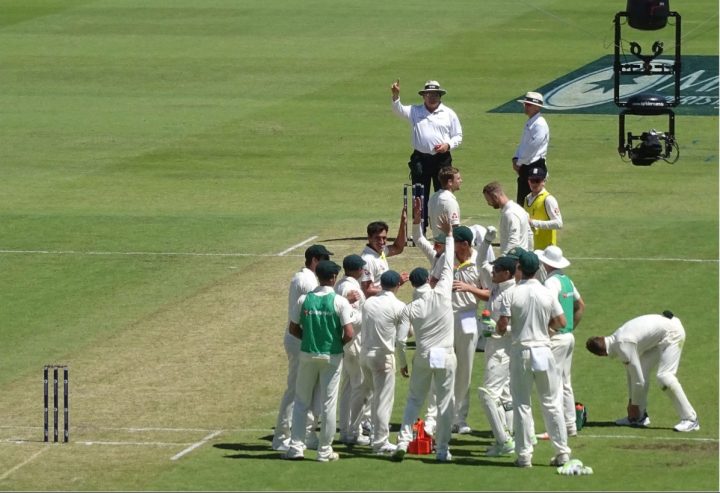Michael Hussey: what a pain in the arse. Two years of being crap, only to rediscover his form when least convenient for us. Funny how often that happens against England.
You probably took a bleary-eyed first glance at the score this morning and thought 220-5 wasn’t too bad, especially after being 96-1 at lunch. But then you’ll have noticed that at one stage we’d reduced them to 143-5, and it could have been so different.
Some people will today say we squandered a huge chance to wrap up their innings. But cricket, it’s always seemed to me, doesn’t work quite like that. The pendulum swings; there is ebb and flow. Clusters of wickets are almost always followed by a rally in the form of a significant partnership.
Plays starts half an hour earlier tonight – at 9.30 local time – which could make conditions a touch more bowler friendly. If we can nip this pair out quickly, we should restrict the lead to around 50. But if not…
Jimmy Anderson did much today to shake off the ‘pussy’ tag. Nothing went his way in the first hour; uncharacteristically, he responded with discipline and focus. He bowled the right, slightly full, length, whereas Broad seemed to indulge in what Michael Vaughan describes as his ‘pretty bowling’.
Earlier, England reviewed an LBW decision which Hawkeye showed to be hitting the outside of Watson’s leg stump. Under the rules, when the ball only glances the stump, the original decision stands. But it seems terribly unfair that the fielding side still use up one of their reviews in the process. The ball was hitting the wicket – according to the actual laws of cricket, it was out. So why should the fielders be penalised?
Meanwhile, there was an impressive Ashes debut last night for ITV. The channel are screening an hour of highlights at 10pm every evening, on ITV4. Commendably, there was no faffing around, just plenty of action, judiciously chosen. Some highlights editors only show an endless sequence of boundaries, but ITV’s team blended the four-balls with deliveries which beat the bat, and plays-and-misses, giving a much better flavour of the play’s real rhythm.
The commentary comes from Australia’s Channel 9, who were in great form all-round. Shame you can’t switch over to them on Sky’s red button. Bill Lawry was particularly exuberant. His orgasmic cries of joy when the – Victorian – Peter Siddle claimed his hat-trick are best left to the imagination.
Your thoughts, views, predictions…?
Maxie Allen









I had no issue with the ITV4 coverage of the first day – not at all bad in fact – except for it being on ITV4 at all!! OK – in a rare moment of technological bravado I finally bit the bullet recently and invested in a Freeview TV, but if I had not done so…..
Is it too much to ask that the highlight of such a major sporting event – featuring our national summer sport – should appear on at least one of our motley selection of terrestrial channels? Personally I am appalled that they aren’t on the Beeb – where they belong – and having to chase around channels with numbers higher than 2 has been a pain over the years – but I really do feel for those poor souls who can’t get ITV4 (how can there possibly be 4 ITV channels anyway!?)
Bah humbug……
After day one, you could have though Australia had already won back the ashes. They were cock-a-hoop and we were massively deflated as a nation. Yet Boycs was, as ever, the master of reason “wait till both sides have batted”. The first session tomorrow is potentially THE session of the match. 3 wickets for England and they are in the game. 100 runs for 1-2 wickets and the Aussies are in the box seat.
Spot on with the reviews. Perhaps when it reverts to the umpires call the review should be retained. This avoid the double whammy of being denied a legitimate wicket and losing a review.
ITV4 did a good job. Lots of cricket and little padding and “analysis”. I’d just forgotten how partisan the Channel 9 commentators are!
You’re misinterpreting the purpose of the review system (although, so are most of the players). It is not supposed to be used when you think a wicket would be handy and the ball *may* just have feathered the outside edge of leg stump. It is supposed to be used to correct outrageously bad decisions.
If Hawkeye suggests the ball *might* have feathered leg stump, it has not exposed a glaring failure of umpiring, it in fact confirms the umpire has made a good decision. The laws state the the benefit of the doubt be given to the batsmen.
By calling for a review, the fielding captain has held up the game and undermined the umpire by implicitly accusing him of making a howler. When the review confirms the umpire made entirely the correct decision, why should the fielding captain be rewarded with another opportunity to repeat his mistake?
On another note, the second day has put a different perspective on the series. As Michael Slater was saying, it seems that rather than one side getting ahead and steamrollering the other, this may well be a real back-and-forth dogfight, going one way then the next.
I’ve a lot more confidence that England could lose the first Test and still win/draw the series. They showed good fight in coming back today. We’ll see what happens tonight.
THA. Accept your point about the intent of the DRS but there is a reality of it is use (the law of unintended consequences applies).
The Watson decision was not a howler but it was wrong (though for the standing umpire a good one due to the doubt). It could be argued that the DRS undermines the umpire when he has a howler, but supports him when he gets a marginal decision wrong. I guess it comes down to how much human error we want in umpiring decisions?
Either way the DRS is better than no DRS. And I say that as someone on both ends with bat and ball over the years!
Well, there are several things which come in to play here:
Hawkeye (although actually they’re using a rival system in this series) has a margin of error. It’s good but it’s not the final word. As such, the rule they have decided on is that more than fifty percent of the ball must be adjudged to be hitting the stumps for a ‘not out’ lbw decision to be reversed.
This is essentially the same principal an umpire uses anyway. Benefit of the doubt is a practice that has served cricket well and is widely accepted as being right. Hawkeye seems to have resulted in a lot of people losing perspective. A reply shows the outline of the ball slightly overlapping the outline of the stumps, and the commentator says “Ah, not a great call from the umpire”. When looked at with a bit of perspective, the best it suggests is that the polish on the ball might have feathered the varnish on the stumps, yet people are happy to call it a ‘wrong’ decision (I’m talking generally, not about the Watson call).
Show me a batsman in the world who would think it just to be given out because the umpire thinks a ball might have feathered leg, but he’s not sure. Most games would end in about five overs.
Also, if it was judged a not out decision should stand, but the fielding side should keep their challenges because the ball might have been hitting the stumps, we’d end up with the ridiculous result of a batsman being given ‘a bit out’. He’s out enough for the challenger to be considered justified, but not so out that he’s actually out, and can’t score another hundred runs.
Players have brought this on themselves with their cynical use of the system. It was introduced to be a safety net against some of the more shocking decisions some umpires have made, but they’re often using it to second guess consistently excellent umpiring, and having long discussions about the wisdom of an appeal, rather than immediately complaining in the face of an injustice, as the rules require. Broad is a prime example. He openly disrespects umpires when he’s bowling, and has twice recently called for a review when he could hardly have been more plumb.
It’s true, of course, that as soon as you introduce any system people start working out ways to abuse it, or use it to its best advantage.
All the above points are correct, which is why I would argue for scrapping the whole thing. The DRS has not improved a jot the experience of watching or playing cricket. If anything, the reverse – it makes the fall of a wicket extremely anti-climatic, Siddle’s hat-trick being a good example.
I agree. It’s better to use the technology to phase out the consistently bad umpires, which is largely policy already, rather than to debate their merits in front of the crowd and players.
Or, have the umpires make the referrals not the players – although the problem with that is the stick they’d get if they didn’t refer and there was proven to be a mistake…so the they’d end up using it all the time.
Alternatively, DRS could only be for catches, not LBWs. It seems so soulless for a computer to make decisions which dictate the course of a match. And after all, Hawkeye is still only an estimation, just like an umpire’s, albeit a much more sophisticated one.
Yeah, allowing umpires to refer would result in them doing it for every single decision, as they do with run-outs, even when someone’s out by six feet. One over could end up taking twenty minutes.
Can anyone tell me if one of the Commentators on ITV4 Cricket is Tony Grieg please, (pint resting on this).
Yes, Tony G is part of the Australian Channel 9 commentary team. The ITV4 highlights take the C9 commentary.
Much appreciate your answer, many thanks.